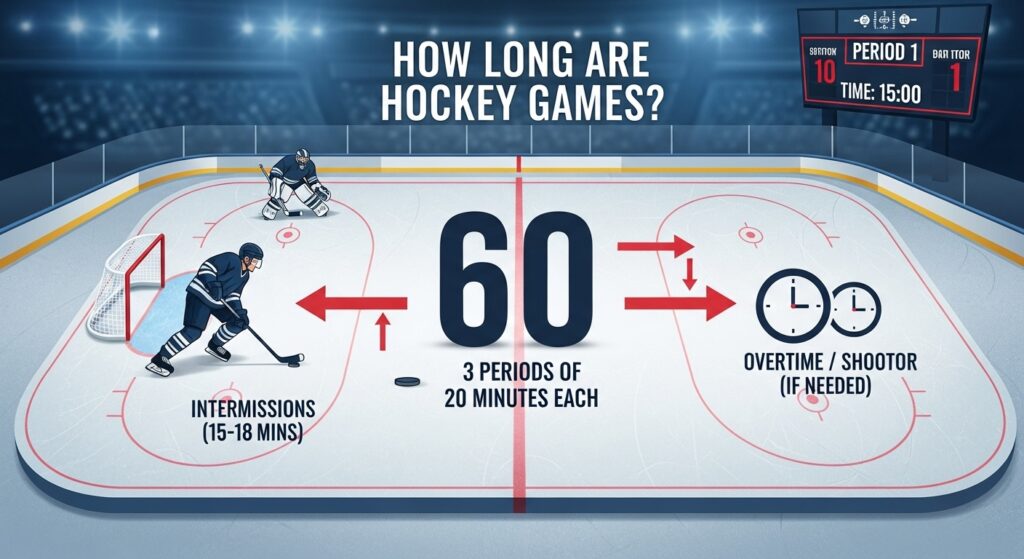In the fast-paced world of sports, understanding game structure is essential for both players and fans. Hockey, known for its speed, skill, and intensity, often prompts a common question: how long are hockey games? While the sport appears continuous and relentless, its official duration is precisely structured to balance athletic performance, strategy, and viewer engagement.
This article explores the length of hockey games across various levels, the factors that influence game time, and why understanding duration is critical for players, coaches, and fans alike.
Understanding Standard Hockey Game Duration
Professional ice hockey games, such as those in the National Hockey League (NHL), follow a standard format that dictates how long the game lasts:
-
Three Periods: A typical game consists of three periods, each lasting 20 minutes of playtime.
-
Intermissions: Two intermissions, usually 15-18 minutes each, separate the periods, allowing players to rest and ice maintenance to occur.
-
Total Play Time vs. Real Time: Although total playtime amounts to 60 minutes, real-world game duration often extends to around 2.5 to 3 hours due to stoppages, penalties, and overtime.
Thus, when discussing how long are hockey games, it is essential to distinguish between actual ice time and elapsed time including breaks.
Variations by League and Level
While professional leagues maintain uniform timing, hockey games vary depending on the competition level:
-
Collegiate Hockey: Typically mirrors professional rules, with three 20-minute periods and similar intermissions, though game stoppages may be slightly shorter.
-
Youth Hockey: Games often consist of shorter periods, ranging from 12 to 15 minutes, to accommodate the endurance levels of younger players.
-
International Hockey: Federations such as the International Ice Hockey Federation (IIHF) follow three-period formats with slight variations in intermission length and overtime rules.
These differences highlight that game duration is adapted to age, skill level, and league requirements while maintaining the integrity and excitement of the sport.
Overtime and Shootouts: Extending Game Duration
In addition to standard play, hockey games frequently extend due to tie-breaking rules:
-
Overtime: Many professional leagues feature sudden-death overtime, which can last from 5 to 20 minutes depending on league rules and regular vs. playoff settings.
-
Shootouts: If overtime does not produce a winner, a shootout may occur, adding several minutes to the total game length.
These mechanisms ensure fair outcomes while introducing extra excitement for spectators. They also significantly affect how long hockey games last in practice, particularly during playoff seasons when sudden-death overtimes can stretch the game far beyond standard durations.
Factors Affecting Game Duration
Several elements influence the actual duration of a hockey game:
-
Stoppages in Play: Goals, penalties, offsides, and icing calls frequently stop the clock, extending real-world game time.
-
Commercial Breaks: Professional broadcasts incorporate commercial breaks, slightly lengthening the event.
-
Player Substitutions: Frequent line changes, a hallmark of hockey strategy, create brief pauses.
-
Injuries or Reviews: Game interruptions for injuries or video reviews can extend the timeline.
Understanding these factors helps fans and coaches plan their time and strategies effectively, especially in tournaments or double-header formats.
Physical Demands and Game Duration
Knowing how long are hockey games is also essential for appreciating the sport’s physical demands:
-
Endurance: Players skate at high intensity for 60 minutes of official playtime, interspersed with short rests during line changes.
-
Strength and Recovery: Intermissions and bench rotations allow athletes to maintain performance across periods.
-
Mental Focus: Continuous vigilance is required, as a single lapse can result in a goal against the team.
The combination of speed, contact, and tactical execution demonstrates why understanding game length is vital for training, conditioning, and performance planning.
Strategic Implications of Game Duration
The structure of hockey games directly affects team strategies:
-
Period Management: Coaches adjust player rotation and tactics to maximize efficiency in each period.
-
Pacing: Teams balance aggressive plays with energy conservation to maintain performance across the full 60 minutes.
-
Endgame Strategy: Knowing the remaining duration informs decisions like pulling the goalie or implementing power plays.
Thus, awareness of how long hockey games last is more than a curiosity—it shapes in-game tactics and team management.
Viewing Experience: Fans and Spectators
Game duration also affects spectators and fan engagement:
-
Live Attendance: Fans plan schedules around full game length, including intermissions and potential overtimes.
-
Broadcast Planning: Television networks schedule programming to accommodate standard and extended games.
-
Excitement and Engagement: Knowledge of overtime potential adds suspense and emotional investment for viewers.
Understanding game duration ensures that hockey remains accessible, enjoyable, and strategically engaging for all audiences.
Historical Context: Evolution of Game Length
Historically, hockey game duration has evolved to optimize performance and entertainment:
-
Early hockey games featured two periods of variable length, often resulting in inconsistent playtime.
-
Standardization of three 20-minute periods allowed for predictable scheduling and athlete endurance planning.
-
Introduction of overtime and shootouts modernized the sport, ensuring fair outcomes while heightening excitement.
This evolution underscores that game duration is a carefully considered aspect of hockey, balancing athlete performance, viewer experience, and competitive integrity.
Global Variations and Adaptations
Hockey is played worldwide, and game length can vary due to local rules and environmental factors:
-
Europe: Many leagues follow IIHF regulations with minor adjustments to intermissions.
-
Asia: Ice hockey leagues adopt slightly shorter periods for developmental purposes.
-
Outdoor and Exhibition Matches: Games may be modified in length for festivals or charity events.
These variations demonstrate the sport’s flexibility while retaining the core question of how long hockey games last.
Key Takeaways
-
Standard Duration: Professional hockey games last 60 minutes of play, divided into three periods of 20 minutes each.
-
Real-World Duration: Including intermissions, stoppages, and potential overtimes, games often extend to 2.5–3 hours.
-
Variations Exist: Youth, collegiate, and international competitions may modify period length, intermissions, and tie-breaking rules.
-
Strategic Importance: Duration affects player conditioning, in-game tactics, and coaching decisions.
-
Fan Considerations: Knowing game length aids in scheduling, engagement, and maximizing the viewing experience.
By understanding these dynamics, players, coaches, and fans can fully appreciate the physical, strategic, and entertainment aspects of hockey.
Conclusion
Hockey is a sport that combines speed, skill, strategy, and endurance, all framed within a carefully regulated time structure. When asking “how long are hockey games?”, the answer depends on the level of play, league rules, and specific circumstances like overtime or shootouts.
From professional NHL matches to youth leagues, the game’s duration is designed to balance performance, fairness, and spectator enjoyment. Recognizing the nuances of game length deepens appreciation for the sport and enhances preparation for anyone involved—whether on the ice, in the coaching box, or in the stands.
Ultimately, understanding game duration is not just about the clock; it’s about strategy, resilience, and the experience of hockey in all its thrilling dimensions.






